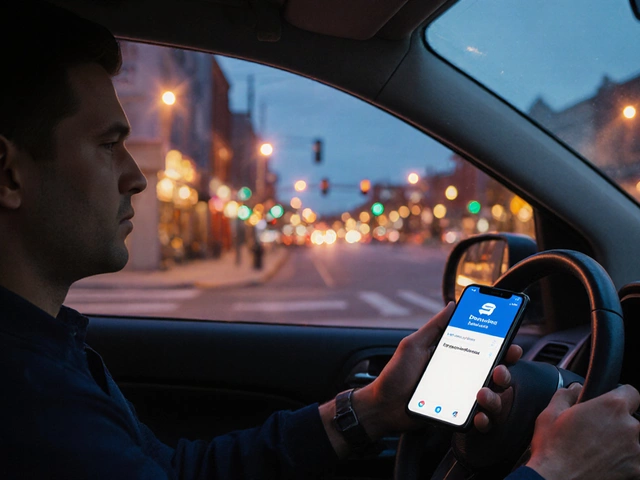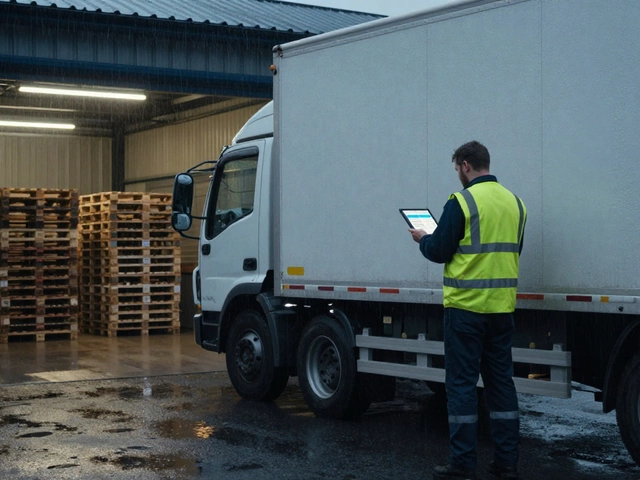Order something at 4pm, and watch as it lands on your doorstep by 9pm. Or send a last-minute birthday present across the country, only to have it arrive before your worrying text. Speed runs the modern world, especially when it comes to getting stuff from point A to point B. If your head spins at the blur of couriers and promises, you're not alone. Let’s get to the bottom of the real fastest mail service—the one that doesn’t leave you refreshing a tracking page every five minutes or apologising for late gifts.
How Fast Can Mail Really Travel?
Waiting for a package is an impatience test nobody asked for. The good news? The major mail carriers have been in a kind of arms race, all fighting for the prize of “fastest delivery.” Speed boils down to more than flashy adverts. It's a combination of technology, ground teams, strategic hubs, careful routing, and even weather monitoring. So, how fast is fast these days?
Let’s put down some numbers. Royal Mail's Special Delivery Guaranteed by 9am can take a letter from Bristol to London in less than 12 hours—pretty wild compared to standard post that sometimes spends days meandering cross-country. FedEx and UPS guarantee next morning delivery between big UK cities, even offering same-day options in some postcodes. DHL Express delivers international letters and small parcels to the US or mainland Europe in 24-48 hours, sometimes faster than you'd expect a pizza to arrive on a rainy Friday.
Speed isn’t just about planes. Many carriers rely on a network of vans, bikes, drones, and even electric cargo scooters weaving through city traffic while everyone else sits in jams. In London, for example, CitySprint’s pushbike couriers have been clocked outpacing taxis in rush hour, thanks to smart route-planning and some risky pedal power.
But the absolute record holders? That’s often down to dedicated same-day specialists. Companies like CitySprint and Addison Lee can take an envelope or parcel from Bristol and get it to Birmingham, Manchester, or Cardiff in just a few hours—sometimes less—when you opt for a premium or direct van service. These aren’t cheap, but when stakes are high (legal papers, medical samples, irreplaceable keys), the speed can pay for itself.
Here’s an apples-to-apples comparison of current fastest services:
| Provider | Fastest UK Domestic Service | Fastest International Service | Who Uses Them? |
|---|---|---|---|
| Royal Mail | Same Day (specialist), Guaranteed by 9am Next Day | Global Express: Next Day to EU/US major cities | Businesses, individuals, law firms |
| FedEx | Same Day City, Next Day City | International Priority: Next Day US/EU | Corporates, high value shippers |
| DHL | Express Domestic, Same Day | Express Worldwide: 1-2 days major cities | Tech, medical, e-commerce |
| CitySprint | Same Day Ultra-Express | Export Sameday (specialist) | Legal, TV studios, hospitals |
This table shows the top tier providers and their quickest options. Not every service is available everywhere—sometimes postcode lotteries, weather, or customs can gum up the works. But with the right postcode, the right provider, and enough budget, you can have a package cross half the country by dinnertime or hit a New York mailbox by tomorrow lunch.
Though drones and robot couriers hog headlines, most real-life super-fast deliveries are all about human know-how, clever networks, and business partnerships. Even local pet stores in Bristol are now hopping on “shop to door in two hours” schemes, using the infrastructure built by pizza chains or taxi companies. I've had Max's favorite dog treats dropped off by courier so quick, he barely had time to wag his tail at the window. That’s how the world’s changing—everything’s speeding up and old assumptions about slow mail are, well, just plain old.

What Makes a Mail Service Fast?
If you think speed just comes from faster vans or upgraded airplanes, you’re missing most of the story. Let’s lift the curtain on what’s actually going on behind the scenes of the fastest mail services.
First, there's the matter of logistics hubs. Companies like Royal Mail and DHL invest millions each year redesigning their main sorting centres so parcels barely touch the ground. Liverpool’s Royal Mail North West Hub opened in 2023 and doubled processing speed within the first month—with camera-based sorting, AI algorithms, and trays whirling along like a jet-powered sushi belt. Every second saved on sortation adds up when you’re sending out millions of items overnight.
Second, routes and real-time tracking have become almost an obsession for these companies. If you’ve tracked a parcel lately, you’ve seen routes update minute-by-minute, with some couriers now letting you WhatsApp their drivers for reroutes if needed. FedEx’s “SenseAware” system can even track the temperature and tilt of a package, alerting you if something’s gone wrong in transit—hugely valuable for medical shipments.
Staffing is another part of the speed puzzle few people talk about. In the old days, tons of overtime and late nights made next-day delivery possible. Now, automation and flexible shifts mean there’s always someone at the depot—rain, shine, or rail strike. Some UK couriers even quietly use “gig-economy” models, summoning a fleet of drivers in real time, like how Uber dispatches rides. The tech behind the scenes is just as important as those “guaranteed” badges on the tracking page.
The speediest services also often have package restrictions. Same-day couriers can whisk a laptop or document from Bristol to London at a blistering pace, but don't expect them to take your grand piano or the family Christmas tree. Internationally, air freight capacity has exploded since 2020, with DHL and FedEx inking deals with passenger airlines to fill empty belly-space with high-value express parcels. That means there are now more planes—and more space—for truly urgent packages to hop continents overnight.
Here are some useful tips to really hit warp speed with your own shipments:
- Book early in the day for same-day delivery. Cut-offs are real—miss the 11am slot, and it’s next morning for your parcel.
- Use the fastest available postcode checker on each courier’s website before booking.
- Package neatly and label clearly; unlabelled or misspelled addresses are the silent killer of fast delivery speeds.
- Upgrade to real-time tracking, especially for high-value shipments. If anything goes sideways, you’ll know instantly.
- For international urgency, check customs and paperwork requirements. Even premium services can’t speed past paperwork mistakes.
Also, if you run a business and speed is your brand, consider integrating your website or inventory with a courier’s API. That’s how tons of e-commerce stores in Bristol now offer same-day delivery. Orders zip from your screen straight to a waiting driver, skipping all the slow manual steps. Now that’s fast.

What’s Next for High-Speed Mail?
What about tomorrow’s fastest mail service? Let’s talk about the future—because this race for speed isn’t close to finished. The next few years are going to bring both wild tech and smart tweaks to the systems we use right now.
First up: drones. Still rare (and more a novelty for show-offs than most real deliveries), there are pilot schemes—like the one in Orkney, launched by Royal Mail in 2024—that deliver medical supplies across challenging UK terrain in just minutes. It’s not practical for every package, but as regulations loosen and drones grow larger, you’ll likely see more remote villages and hospitals getting their post the sci-fi way.
Autonomous vehicles are another frontier. Starship delivery robots already ferry groceries and small parcels in Milton Keynes and Cambridge, beating both traffic jams and parking problems. It’s likely the major couriers will scale this up—urban hubs especially benefit from robots sneaking through traffic when regular vans get stuck. Combine this with traffic prediction, route-optimisation apps, and the sheer horsepower of new electric vehicles, and future mail speeds could leave today’s express services in the dust.
But don’t overlook the small upgrades. Expect more pickup drop-off lockers at supermarkets and train stations. E-commerce sites are increasingly “promising” two-hour delivery in dense urban areas—sometimes using taxi and food delivery apps as backup during peaks. More ultra-fast courier collectives are forming—networks of local drivers, often tapping into the gig economy. There's no single winner here, just a wild west of fast options fighting for customers.
Here are some predictions and stats to watch as 2025 rolls on:
- The fastest recorded cross-UK mail run in 2025? A Bristol-to-Edinburgh medical courier covering 358 miles in just under 5 hours (helped by a police escort for a transplant organ—proof it’s all about urgency and resources).
- Same-day delivery volumes have surged 35% in the UK since 2022, with urban areas leading and local independent shops increasingly joining the party.
- Expect to see hybrid services—mixes of bikes, vans, trains, even e-scooters—for complex city routes where traditional vans keep getting delayed.
- The biggest speed killer: postcode mismatches and failed home deliveries. Use local pickup points for the fastest, least stressful option.
- International express demand is forecast to rise 19% annually through 2026 in the UK, driven by cross-border e-commerce growth and businesses who simply can’t afford to wait.
If you're an ordinary person—say, the kind ordering treats for your impatient dog, Max—this all means you'll have more choices, quicker deliveries, and less time wasted anxiously peeking out the window. For businesses, missing a “next day” promise feels ancient already. Now, it’s about shaving hours off, not days. Forget waiting around—use the fastest mail service and get on with your day. Speed is just normal now.





